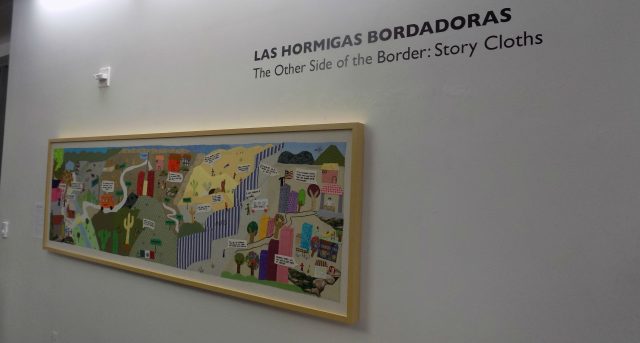Central Library will host “Las Hormigas Bordadoras” art exhibition in its second floor gallery until the end of November.
All of the work featured was designed by a group of women from Tanivet, Oaxaca, Mexico. These women choose to narrate their stories of the effects of immigration on their community through quilting and embroidery, allowing people who stop by to gain a perspective on the other side of the border.
While the artists come from the same community, each artist uses the opportunity to tell stories about their own childhood, their adult lives or their children. Whether living in Tanivet while their father crossed the border for economic opportunities or watching their children seek educational opportunities or resources within the United States, immigration has affected them all in some way.
“When I’m weaving or when I’m working on my pieces, I feel relaxed. I feel calm,” one of the artists said in the documentary video, “New Codex: Oaxaca – Immigration and Cultural Memory.”

For the women and children within this community, patchwork is a revival of a pastime many of their mothers and grandmothers participated in. This skill allowed previous generations of women to make quilts for family members to keep them warm.
In 2010, cultural promoter, curator and Women Artist and Maize (MAMAZ) founder Marietta Bernstorff began teaching classes to the women and children of the Tanivet community. Her intentions included teaching them a new skill, empowering them and offering a familiar source of income to a community where jobs are scarce.
“All of the work that was done by the ladies. We pay them outright for it. Nothing goes uncommissioned,” said University of Wisconsin Professor Carolyn Kallenborn, who curated the Central Library exhibit.

Kallenborn, an exhibition curator for the Global Artist Initiative, works closely with the women who design the quilts. This exhibition is part of a larger initiative focused on exposing local audiences in Wisconsin to global artisans while developing lasting relationships with artists around the world.
“Since we had no support, no financial support of any kind, we needed to make a network system of different creators, artists, educators to come in and donate one hour of their time to this village,” Bernstorff said in the documentary.
Each piece placed in the exhibition can go home to a patron who chooses to purchase the work. The profits of each piece will go back into funding the initiative and supplies for creating more artwork.
“I’ve been working down in Mexico for about fifteen years,” Kallenborn said in an interview.
She and students who travel along will often bring big bags of fabric they have either purchased or someone has donated. These fabrics will then go to the women to create what they choose.
“For the pieces, I ask them what they want and I don’t bargain with them,” she said.
Some of the quilts are small and others can fill up an entire section of the wall, but each piece is unique, offering details about the women who constructed them. Illuminating the aspects of everyday life, family, work, the quilts give a vivid picture of life in Oaxaca for these particular women.
As of now, the work of the Global Artists Initiatives is mostly volunteers who care about art and sharing the work of artisans from local communities around the world in exhibitions, stores or trunk shows. The initiative operates as part of larger non-profit- 4W Initiative, focused on women, well-being, Wisconsin and the world.
“My personal goal on this is to make it a real business so it’s not just based on volunteering, so the people can make a sustainable living,” Kallenborn said.




























